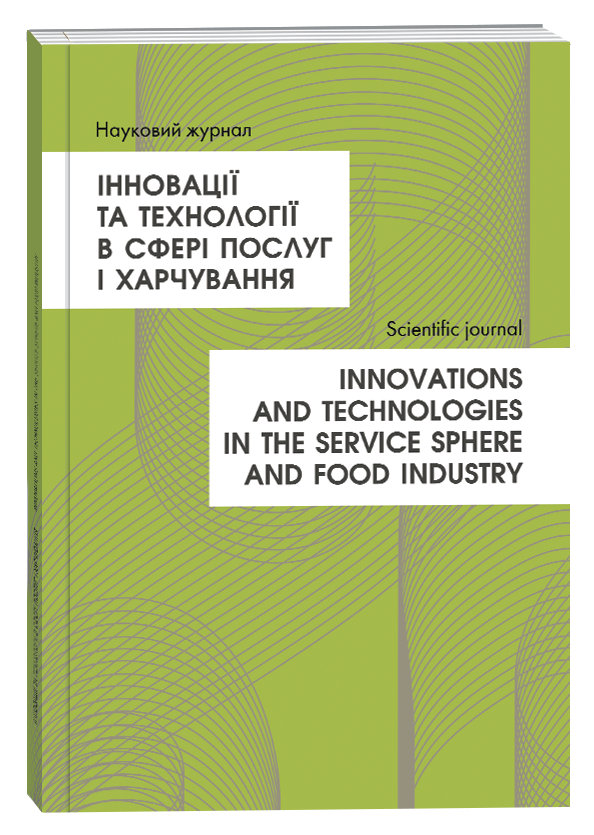ESTABLISHING THE POSSIBILITIES OF USING THE WASTE SUBSTRATE AFTER GROWING LENTINULA EDODES
Abstract
In the context of modern food challenges to produce a wide range of protein-based foods, including functional and health foods and vegetarian food, artificial cultivation of mushrooms is attracting attention. Currently, the food industry in Ukraine is focused on the artificial cultivation of various types of mushrooms. Currently, the food industry in Ukraine is focused on the artificial cultivation of mushrooms of various species. In particular, this article will focus on mushrooms of the genus Lentinula edodes. After mushroom cultivation, large quantities of waste substrate remain, which is mostly the remains of lignocellulosic phytomass. Under current environmental rules and regulations, the issue of waste-free or closed-cycle production is becoming increasingly important. The aim of the study is to investigate the micro- and macroelement composition and general microbiological activity of the spent Lentinula edodes substrate in order to find ways to bioconvert this substrate and the possibility of its further use in the food industry, for organic farming or as a raw material for biofuel production. The content of micro- and macronutrients was determined using a half-beam photometer. To study the microbiological activity of the spent substrate after mushroom cultivation, aqueous extract and sterile pieces were used. For microbiological inoculation, meat-peptone agar, Slate-Bartley medium, and Chapek's medium were used as nutrient media. According to the results of the micro- and macroelemental and microbiological study on the possibility of using the spent Lentinula edodes substrate, a number of regularities and interactions were established, which opens up wide prospects for further research on the spent substrate after cultivation of Lentinula edodes with its subsequent purification and enrichment of food with the obtained dietary fibres, or the creation of new functional foods based on the obtained food prebiotics of cellulosic origin. The obtained results open up new areas of research on the search for biologically active components of the spent Lentinula edodes substrate in the food industry and in the agricultural sector.
References
Цизь О. М. Іванова Т. В. Патика М. В. Активізація трофічних зв’язків у системі «субстрат – рослина» за дії біопрепаратів під час оздоровлення агроценозів Таврійський науковий вісник. 2020. № 112. С. 242–248.
Жданова Н. М., Олішевська С. В., Василевська А. I., Айзенберг В. Л., Курченко I. М., Артишкова Л. В., Наконечна Л. Т., Капічон Г. П. Скринінг штамів мікроміцетів, що здатні рости та руйнувати целюлозовмісний субстрат. Мікробіологія і біотехнологія. 2008. № 3(4). С. 58–63. DOI: https://doi.org/10.18524/2307-4663.2008.3(4).105067
Rawiwan, P., Peng, Y., Paramayuda, G. P. B., Quek S. Red seaweed: A promising alternative protein source for global food sustainability. Trends in Food Science & Technology 2022. Volume 123, № 5, P. 37–56.
Бурда Н. Є., Журавель І. О. Вивчення елементного складу грибів кордіцепс, шиїтаке, рейши та майтаке. Збірник наукових праць співробітників НМАПО ім. П. Л. Шупика. 2016. Вип. 23, кн. 1. С. 308–312.
Веліканов, О., Андрусишина, І. Модифікування мікроелементного складу грибів шиїтаке (LENTINUS EDODES) . Продовольчі ресурси, 2022. 10(18), 43–50. DOI: https://doi.org/10.31073/foodresources2022-18-04
Голуб Г., Гайденко О. Диверсифікація виробництва: біоконверсія, енергетика та вирощування грибів. Ідеї & Тренди. 2023 р. URL: https://agro-business.com.ua
Федоритенко Н. О. Розробка складу та технології лікувально-профілактичного засобу у формі капсул на основі грибів Шиїтаке: автореф. дис. канд. фармац. наук: 15.00.01. Харків, 2010. 32 с.
Бандура І. І. Вплив складу субстратів на морфологічні та біохімічні показники PLEUROTUS CITRINOPILEATUS SINGER. Вісник аграрної науки. 2021. № 2. С. 11–18. DOI: https://doi.org/10.31073/agrovisnyk202102-02
Ogawa K., Yashima T. MRI visualization of shiitake mycelium growing in woodchip blocks used for shiitake mushroom cultivation. Magnetic Resonance Imaging. 2019. Vol. 58. P. 90–96. DOI: https://doi.org/10.1016/j.mri.2019.01.004
Chen F., Martín C., Lestander T. A., Grimm A., Xiong S. Shiitake cultivation as biological preprocessing of lignocellulosic feedstocks – Substrate changes in crystallinity, syringyl/guaiacyl lignin and degradation-derived by-products. Bioresource Technology. 2022. Vol. 344, Part B. DOI: https://doi.org/10.1016/j.biortech.2021.126256
ДСТУ 7670:2014 Сировина і продукти харчові. Готування проб. Мінералізація для визначення вмісту токсичних елементів.
Tsyz O. M. Ivanova T. V. Patyka M. V. (2020). Aktyvizatsiia trofichnykh zviazkiv u systemi «substrat – roslyna» za dii biopreparativ pid chas ozdorovlennia ahrotsenoziv [Activation of trophic relations in the system ‘substrate - plant’ under the influence of biological products during the improvement of agrocenoses] Tavriiskyi naukovyi visnyk. № 112. s. 242–248. (in Ukrainian)
Zhdanova N. M., Olishevska S. V., Vasylevska A. I., Aizenberh V. L., Kurchenko I. M., Artyshkova L. V., Nakonechna L. T., Kapichon H. P. (2008). Skryninh shtamiv mikromitsetiv, shcho zdatni rosty ta ruinuvaty tseliulozovmisnyi substrat Screening of microbial strains capable of growing and degrading cellulose-containing substrates]. Mikrobiolohiia i biotekhnolohiia. № 3(4), s. 58-63 (in Ukrainian)
Rawiwan, P., Peng, Y., Paramayuda, G. P. B., Quek S. (2022). Red seaweed: A promising alternative protein source for global food sustainability. Trends in Food Science & Technology, Vol. 123, № 5, p. 37–56.
Burda N. Ye., Zhuravel I. O. (2016).Vyvchennia elementnoho skladu hrybiv korditseps, shyitake, reishy ta maitake [Study of the elemental composition of the fungi Cordyceps, Shiitake, Reishi and Maitake] Zbirnyk naukovykh prats spivrobitnykiv NMAPO im P. L. Shupyka. is. 23, book 1. p. 308–312. (in Ukrainian)
Velikanov, O., Andrusyshyna, I. (2022). Modyfikuvannia mikroelementnoho skladu hrybiv shyitake (LENTINUS EDODES) [Modification of trace element composition of shiitake mushrooms (LENTINUS EDODES)]. Prodovolchi resursy, № 10 (18), s. 43–50. DOI: https://doi.org/10.31073/foodresources2022-18-04 (in Ukrainian)
Holub H., Haidenko O. (2023). Dyversyfikatsiia vyrobnytstva: biokonversiia, enerhetyka ta vyroshchuvannia hrybiv [Diversification of production: bioconversion, energy and mushroom cultivation]. Idei & Trendy. Available at: https://agro-business.com.ua (in Ukrainian)
Fedorytenko N. O. (2010). Rozrobka skladu ta tekhnolohii likuvalno-profilaktychnoho zasobu u formi kapsul na osnovi hrybiv shyitake: avtoref. dys. kand. farmats. nauk: 15.00.01 [Development of composition and technology of therapeutic and prophylactic agent in the form of capsules based on Shiitake mushrooms: author's abstract of the dissertation of the candidate of pharmaceutical sciences: 15.00.01]. Kharkiv. 32 p. (in Ukrainian)
Bandura I. I. (2021). Vplyv skladu substrativ na morfolohichni ta biokhimichni pokaznyky PLEUROTUS CITRINOPILEATUS SINGER [Influence of substrate composition on morphological and biochemical parameters of PLEUROTUS CITRINOPILEATUS SINGER]. Visnyk ahrarnoi nauky, № 2. s. 11–18. (in Ukrainian)
Ogawa K., Yashima T. (2019). MRI visualization of shiitake mycelium growing in woodchip blocks used for shiitake mushroom cultivation. Magnetic Resonance Imaging, vol. 58, pp. 90–96. DOI: https://doi.org/10.1016/j.mri.2019.01.004
Chen F., Martín C., Lestander T. A., Grimm A., Xiong S. (2022)Shiitake cultivation as biological preprocessing of lignocellulosic feedstocks – Substrate changes in crystallinity, syringyl/guaiacyl lignin and degradation-derived by-products. Bioresource Technology, vol. 344, part B. DOI: https://doi.org/10.1016/j.biortech.2021.126256
DSTU 7670:2014 Syrovyna i produkty kharchovi. Hotuvannia prob. Mineralizatsiiadlia vyznachannia vmistu toksychnykh [DSTU 7670:2014 Sirovina and food products. Samplepreparation. Mineralizationforthe preparationofinsteadoftoxic]. (inUkrainian)



